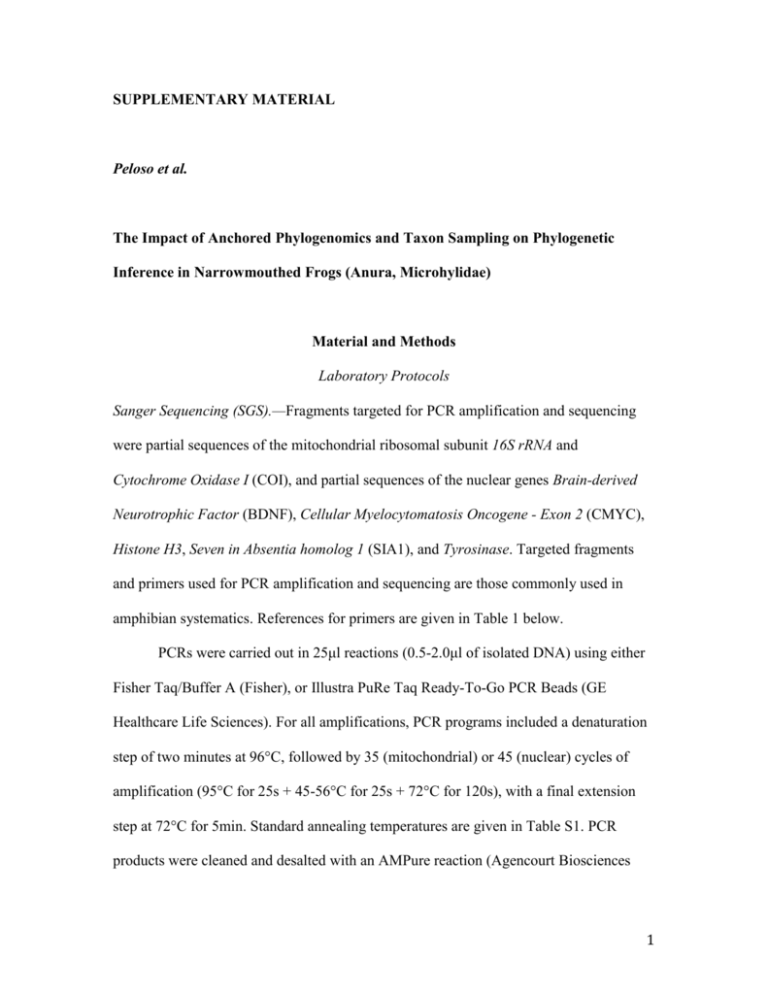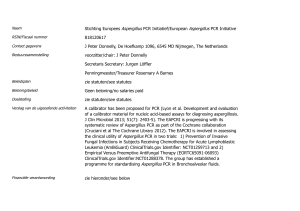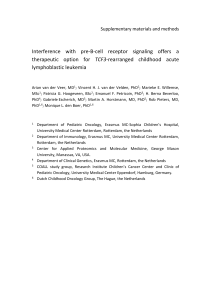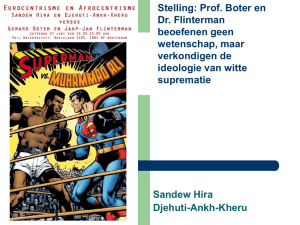Supporting Informatoion - Text S1.
advertisement

SUPPLEMENTARY MATERIAL Peloso et al. The Impact of Anchored Phylogenomics and Taxon Sampling on Phylogenetic Inference in Narrowmouthed Frogs (Anura, Microhylidae) Material and Methods Laboratory Protocols Sanger Sequencing (SGS).—Fragments targeted for PCR amplification and sequencing were partial sequences of the mitochondrial ribosomal subunit 16S rRNA and Cytochrome Oxidase I (COI), and partial sequences of the nuclear genes Brain-derived Neurotrophic Factor (BDNF), Cellular Myelocytomatosis Oncogene - Exon 2 (CMYC), Histone H3, Seven in Absentia homolog 1 (SIA1), and Tyrosinase. Targeted fragments and primers used for PCR amplification and sequencing are those commonly used in amphibian systematics. References for primers are given in Table 1 below. PCRs were carried out in 25μl reactions (0.5-2.0μl of isolated DNA) using either Fisher Taq/Buffer A (Fisher), or Illustra PuRe Taq Ready-To-Go PCR Beads (GE Healthcare Life Sciences). For all amplifications, PCR programs included a denaturation step of two minutes at 96°C, followed by 35 (mitochondrial) or 45 (nuclear) cycles of amplification (95°C for 25s + 45-56°C for 25s + 72°C for 120s), with a final extension step at 72°C for 5min. Standard annealing temperatures are given in Table S1. PCR products were cleaned and desalted with an AMPure reaction (Agencourt Biosciences 1 Corporation) on a Beckman Coulter Biomek 2000 robot. Cycle sequencing using BigDye Terminators v. 3.0 (Applied Biosystems) was run in 10 μL reactions following the protocol of Platt et al. (2007), and products were cleaned and desalted in a Cleanseq reaction (Agencourt Biosciences Corporation) on the Biomek robot. Sequencing was accomplished on an ABI 3730XL automated sequencer. Samples were sequenced in both directions to check for sequencing errors and ambiguities. Contigs and sequence editing were done in Geneious version 6.1.6 (Biomatters). Sequences were trimmed to the region within the primers set. The 16S fragment was sequenced in two overlapping fragments (primer pairs L2A/H10 + AR/BR) and sequences were trimmed to the region inside the pair L2A/BR. 2 Table 1. Primers used for PCR amplification (with annealing temperatures) and sequencing of loci employed in this study using standard Sanger Sequencing techniques (see Material and Methods in main text). Loci Length (bp) Mitochondrial Ribosomal Subunit 16S Cytochrome Oxydase I Brain-derived Neurotrophic Factor (BDNF) 658 Primer Sequence (5' > 3') AR (part 2) BR (part 2) L2A (part 1) H10 (part 1) COI.PF-A COI.PR-A CGCCTGTTTATCAAAAACAT CCGGTCTGAACTCAGATCACGT CCAAACGAGCCTAGTGATAGCTGGTT TGATTACGCTACCTTTGCACGGT TTTCAACHAAYCAYAAAGAYATYGG TANACTTCNGGGTGDCCAAARAATCA BDNF.Amp.F1 ACCATCCTTTTCCTTACTATGG 700 BDNF.Amp.R1 CTA TCT TCC CCT TTT AAT GGT C Cellular Myelocytomatosis Oncogene - Exon 2 (CMYC) Histone H3 328 Seven in Absentia homolog 1 397 Tyrosinase Primer Name cmyc1U GAGGACATCTGGAARAARTT cmyc-ex2 R TCATTCAATGGGTAAGGGAAGACC H3F H3R SIA1 SIA2 ATGGCTCGTACCAAGCAGACVGC ATATCCTTRGGCATRATRGTGAC TCGAGTGCCCCGTGTGYTTYGAYTA GAAGTGGAAGCCGAAGCAGSWYTGCATCAT TyrC GGCAGAGGAWCRTGCCAAGATGT TyrG TGCTGGCRTCTCTCCARTCCCA 532 Standanrd Annealing Source Temperature 48oC Palumbi et al., 1991 Palumbi et al., 1991 o 48 C Hedges, 1994 Hedges, 1994 45-48oC Peloso et al. 2014 Peloso et al. 2014 o 52 C van der Meijden et al, 2007 van der Meijden et al, 2007 o 52 C Crawford (2003) Wiens et al. (2005) o 52 C 52oC 52-56oC Colgan et al., 1999 Colgan et al., 1999 Bonacum et al., 2001 Bonacum et al., 2001 Bossuyt and Milinkovitch, 2000 Bossuyt and Milinkovitch, 2000 3 References Bonacum, J., DeSalle, R., O’Grady, P., Olivera, D., Wintermute, J., Zilversmith, M. 2001. New nuclear and mitochondrial primers for systematics and comparative genomics in Drosophilidae. Drosophila Information Service 84, 201-204. Bossuyt, F., Milinkovitch, M. C. 2000. Convergent adaptive radiations in Madagascan and Asian ranid frogs reveal covariation between larval and adult traits. PNAS 97, 6585-6590. Colgan, D. J., McLauchlan, A., Wilson, G. D. F., Livingston, S. P., Edgecombe, G. D., Macaranas, J., G., C. 1999. Histone H3 and U2 sn-RNA DNA sequences and arthropod molecular evolution. Australian Journal of Zoology 46, 419-437. Crawford, A. J. 2003. Huge populations and old species of Costa Rican and Panamanian dirt frogs inferred from mitochondrial and nuclear gene sequences. Molecular Ecology 12, 2525-2540. Hedges, S. B. 1994. Molecular evidence for the origin of birds. Proceedings of the National Academy of Sciences, United States of America 91, 2621-2624. Palumbi, S. R., Martin, A., Romano, S., Mc-Millan, W. O., Stice, L., Grabawski, G. 1991. The simple fool’s guide to PCR, version 2.0. Privately published, Honolulu. Peloso, P. L. V., Forlani, M. C., Motta, A. P., Gaucher, P., Sturaro, M. J., Wheeler, W. C. 2014. Phylogeny, taxonomic revision, and character evolution of the genera Chiasmocleis and Syncope (Anura, Microhylidae) in amazonia, with descriptions of three new species. Bulletin American Museum of Natural History 386, 1-111. 4 Platt, A. R., Woodhall, R. W., George-Jr, A. L. 2007. Improved DNA sequencing quality and efficiency using an optimized fast cycle sequencing protocol. BioTechniques 43, 58-62. van der Meijden, A., Vences, M., Hoegg, S., Boistel, R., Channing, A., Meyer, A. 2007. Nuclear gene phylogeny of narrow-mouthed toads (Family: Microhylidae) and a discussion of competing hypotheses concerning their biogeographical origins. Molecular Phylogenetics and Evolution 44, 1017-1030. Wiens, J. J., Fetzner, J. W., Parkinson, C. L., Reeder, T. W. 2005. Hylid frog phylogeny and sampling strategies for speciose clades. Systematic Biology 54, 719-748. 5


